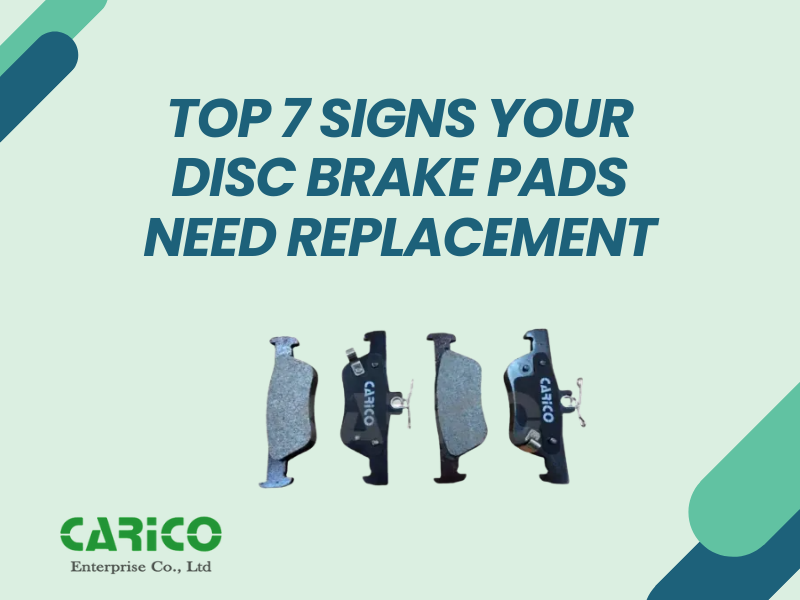Top 7 Signs Your Disc Brake Pads Need Replacement

Disc brake pads are one of the most important safety components on your vehicle—but they’re also one of the most commonly neglected. As the main point of contact between your wheels and your braking system, disc brake pads undergo extreme pressure and temperature changes every time you slow down or stop. Over time, they wear out—and knowing when to replace them is essential for maintaining optimal braking performance and vehicle safety.
Here are the top 7 signs that your disc brake pads may be worn out and due for replacement.
1. Squealing or Screeching Noises
One of the first indicators of worn brake pads is a high-pitched squealing sound when you press the brake pedal. Most brake pads are designed with a built-in wear indicator—a small metal tab that makes contact with the brake rotor once the pad wears down to a certain point. This noise is a warning signal that your brake pads are near the end of their life.
Tip: If the squealing turns into grinding, it likely means the pads are completely worn through and the backing plate is contacting the rotor, which can cause serious damage.
2. Grinding or Growling Sounds
A metal-on-metal grinding noise usually means your brake pads are completely worn out. At this point, the metal backing plate is directly rubbing against the brake disc, which can severely damage the rotor and increase repair costs. If you hear grinding when braking, it's time to stop driving and replace the pads immediately.
3. Increased Stopping Distance
Have you noticed that it takes longer for your vehicle to come to a full stop? This can be a sign that your brake pads have worn thin and can no longer provide the proper amount of friction. A delayed stopping response increases your risk of rear-end collisions and is especially dangerous in wet or emergency situations.
4. Vibration or Pulsation When Braking
A worn or uneven brake pad can cause vibrations or pulsing in the brake pedal when you apply pressure. This could also be a sign of brake disc warping, often caused by prolonged use of worn pads. Either way, it means your braking system is no longer functioning smoothly and requires attention.
5. Thin Brake Pad Material (Less Than 3mm)
You can perform a visual inspection of your brake pads through the wheel spokes. If the pad material appears thinner than 3 millimeters, it’s time for a replacement. Some vehicles have inspection windows or wear sensors that alert you to low pad thickness. Don’t wait until they wear down to metal.
6. Brake Warning Light Is On
Many modern vehicles come equipped with brake pad sensors that alert the driver via a dashboard warning light. If you see the brake warning light (or a specific message about brake pads), it’s best to get your brakes inspected by a professional as soon as possible.
7. Pulling to One Side While Braking
If your car pulls left or right when braking, it may be due to uneven brake pad wear or caliper issues. Worn pads on one side can cause imbalance and steering instability during braking, especially at higher speeds. This condition not only affects safety but also increases wear on suspension and steering components.
Why Timely Replacement Matters
Failing to replace your disc brake pads in time can lead to:
- Damaged brake rotors (costlier to replace)
- Poor brake performance
- Increased risk of accidents
- Higher repair bills from neglected systems
Regular inspection and preventive maintenance ensure that your braking system stays responsive and effective under all conditions.
Conclusion: Replace Brake Pads Before It’s Too Late
Brake pads are wear-and-tear components—but they’re also one of the most essential elements for driver and passenger safety. Recognizing the early warning signs allows you to address issues promptly, avoid rotor damage, and maintain optimal braking performance.
If you’ve experienced any of the symptoms mentioned in this article, it’s time to check your brake system. Don’t wait until braking becomes unreliable—timely replacement ensures better control, shorter stopping distances, and peace of mind.
Why Choose Carico Brake Pads?
At Carico, we offer a full range of OE-quality disc brake pads for various vehicle applications—from passenger cars to commercial fleets. Our brake pads are engineered to deliver:
- Consistent stopping power
- Quiet operation with low dust
- Excellent durability and fade resistance
- Compatibility with premium brake discs for balanced performance
Need help choosing the right brake pads?
Let our technical team assist you in selecting the ideal brake pad and disc combination for your market or fleet needs.
Contact Carico today to explore our full range of braking solutions for your customers or your vehicle lineup.

